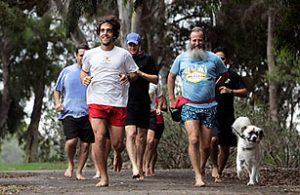
Ann Johansson / Corbis
I don’t particularly enjoy running. On the other hand, I don’t particularly enjoy being overweight and out of shape either, so I do it — usually about three times a week, depending on my work schedule and willpower. But over the years I’ve developed chronic soreness in my knees and lower back, which I attribute at least in part to running — it can’t all be from spending my days sitting in an office chair. I’m not alone; in any given year, about two-thirds of all runners will suffer an injury of some kind. It’s enough to convince runners to spend hundreds of dollars on tricked-out running shoes that promise to protect their tired trotters.
But in some cases, injury inspires runners to do the opposite: dispose of their running shoes altogether. You’ve probably heard about the so-called barefoot running trend, which I write about in this week’s issue of Time, and which a growing group of running enthusiasts — along with the occasional scientist — argue is the best thing you can do for your feet. Basically, the reasoning goes, running shoeless forces you to run the right way. Most of us use a heel-to-toe stride when we run in shoes, but this is possible only because running sneakers have such heavy cushioning in the heel. When running barefoot, runners land on their softer midfoot, and use shorter strides. That puts less stress on sensitive joints, which a December study in the Journal of Injury, Function and Rehabilitation showed.
Presumably, less stress means less injury, but there haven’t yet been any long-term studies comparing the injury rates of barefoot runners to shod ones. But I can tell you, based on my own personal experiment running shoeless in New York City, that going barefoot has its benefits. (Actually, I didn’t go completely barefoot. I used Vibram Five Fingers, which are like rubber gloves for your feet — come on, this is New York City.)
I started with just a couple of miles at a time, running shoeless in Brooklyn’s Prospect Park. At first, I felt mostly soreness in my Achilles tendon, because barefoot running forces you to use your calves much more then when running in shoes. But once that soreness passed, I began to like doing it barefoot. I usually have a pounding stride like an elephant, but running in the Vibrams made me concentrate on my style, falling more lightly on the middle of my foot, with a shorter step. It sounds spacey, but I felt more attuned to the ground — I could actually feel what I was running on. As for my back and knees, they both felt better after running barefoot then they used to after a long jog in my Nikes.
Watch me run barefoot below.
I’m not sure whether I’ll switch to barefoot full time — if I do, I’ll probably wait until the weather warms up — but at the very least, I’ll start reconsidering the wisdom of buying hundred-dollar shoes. — By Bryan Walsh

